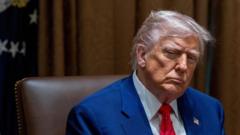After a tumultuous week characterized by sweeping tariff announcements, President Donald Trump finds himself navigating complex trade challenges. In a surprise move, he has placed a temporary freeze on increased tariffs on numerous countries for the next 90 days, even as he escalates tensions in a trade conflict with China. This has led to scrutiny regarding whether Trump is making progress toward his trade ambitions. Here’s a closer examination of five primary goals and their current status.
1) Improved Trade Agreements
Trump’s expectation: Historically, nations have taken advantage of US markets to the detriment of American interests. He introduced a dramatic tariff strategy, advocating for a blanket 10% tariff that impacted not just nations, but also lesser-known territories. As others rush to negotiate to avoid economic fallout, the administration claims to be in talks with over 75 world leaders, including crucial discussions with South Korea and Japan. The implication: The next 90 days will be crucial for forging agreements, highlighting that negotiations signal potential progress in Trump's strategy.
2) Revitalization of American Manufacturing
Trump’s stance: The administration asserts that tariffs can revitalize American manufacturing, protecting domestic industries from foreign competition. Yet, the unpredictable nature of Trump's tariff changes may stifle businesses from committing to long-term investments. Corporate leaders typically seek stability before making significant decisions regarding reshoring production. The uncertainty of which industries will gain benefits complicates potential growth in manufacturing.
3) Confrontation with China
Trump's viewpoint: Framing China as the main adversary in US trade issues, Trump’s administration recently indicated a willingness to engage in economic conflicts. However, as the administration critiques past political leaders for the trade issues faced today, it is clear that the confrontation comes with significant risks. The ongoing feud places the US at odds not only with China, but also potentially alienates allies needed in such a scenario.
4) Generating Revenue
Trump’s claim: The president suggests tariff revenues could significantly bolster the US economy, addressing the national debt and funding tax initiatives. Experts previously estimated that a 10% tariff could yield approximately $2 trillion in revenue over a decade, potentially aiding in deficit reduction. The caveat: The sustainability of this revenue stream may falter as domestic production increases and tariffs diminish the hoped-for influx.
5) Consumer Pricing
Trump’s assertion: The president promotes the idea that increased domestic production will promote competition and result in lower consumer prices. Nonetheless, many analysts fear the impact of high tariffs will reverse these promises, leading to increased costs for consumers, particularly lower-income households. This scenario poses a troubling prospect, potentially jeopardizing Trump's political support and future electoral hopes.
In summary, while Trump's tariff initiative appears to be designed to shore up US economic interests and create advantageous trade relationships, the resulting complexities raise pertinent questions about sustainability, consumer impact, and international relations. As the clock ticks on negotiations, the stakes for all involved are substantial.





















